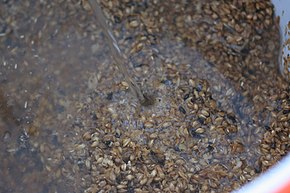**1. Mashing Techniques:**
– Infusion Mashing:
– Most breweries use direct heating for infusion mashing.
– Temperature changes achieved by adding hot water.
– Single-step infusions involve only one rest before lautering.
– Decoction Mashing:
– Involves boiling a portion of grains and returning them to the mash.
– Classifications include one-, two-, and three-step decoctions.
– Traditional method in German and Central European breweries.
– Enzymatic Rests:
– Different temperatures allow specific enzymes to work optimally.
– Optimal temperatures for major mashing enzymes vary.
– Thick mash acts as a buffer for enzymes.
**2. Equipment and Processes:**
– Mash Tun:
– Large breweries use dedicated vessels called ‘mash tuns’ for mashing.
– Heating method based on steam to avoid scorching the malt.
– Proper insulation maintains rest temperatures for up to an hour.
– Mashing-in:
– Mixing of strike water and grist must minimize clumping and oxygen uptake.
– Mashing in must be done at specific temperatures for enzyme activity.
– Decoction Rests:
– Part of the mash is taken out and boiled to caramelize sugars.
– More starches are freed from the grain, leading to efficient extraction.
**3. Mash Rests and Temperatures:**
– Enzymatic Rests:
– Contention exists in the brewing industry regarding optimal enzyme temperatures.
– Enzymes become denatured and inactive after completing their step.
– Decoction Rests:
– The portion drawn off is calculated to reach the next rest temperature.
– The thick mash is boiled for around 15 minutes and returned to the mash tun.
– Mash-out:
– Mash is raised to its mash-out temperature after enzyme rests.
– Exceeding 78°C can cause starch haze and harsh flavors.
**4. Benefits and Results of Mashing:**
– Decoction Mashing:
– Results in unique malty flavor due to Maillard reactions.
– Intensifies malt profile in Bock or Doppelbock beers.
– Mash-out:
– Frees up about 2% more starch and reduces viscosity.
**5. Additional Information and Resources:**
– Etymology:
– Term ‘mashing’ originates from Old English words meaning soft mixture and mixing with hot water.
– Usage of the term dates back to the late 16th century.
– See Also:
– Drink portal
– Technology portal
– Grain bill
– Wort
– Sour mash.
In brewing and distilling, mashing is the process of combining a mix of ground grains – typically malted barley with supplementary grains such as corn, sorghum, rye, or wheat – known as the "grain bill" with water and then heating the mixture. Mashing allows the enzymes in the malt (primarily, α-amylase and β-amylase) to break down the starch in the grain into sugars, typically maltose to create a malty liquid called wort.

The two main methods of mashing are infusion mashing, in which the grains are heated in one vessel, and decoction mashing, in which a proportion of the grains are boiled and then returned to the mash, raising the temperature.
Mashing involves pauses at certain temperatures (notably 45–62–73 °C or 113–144–163 °F) and takes place in a "mash tun" – an insulated brewing vessel with a false bottom.
